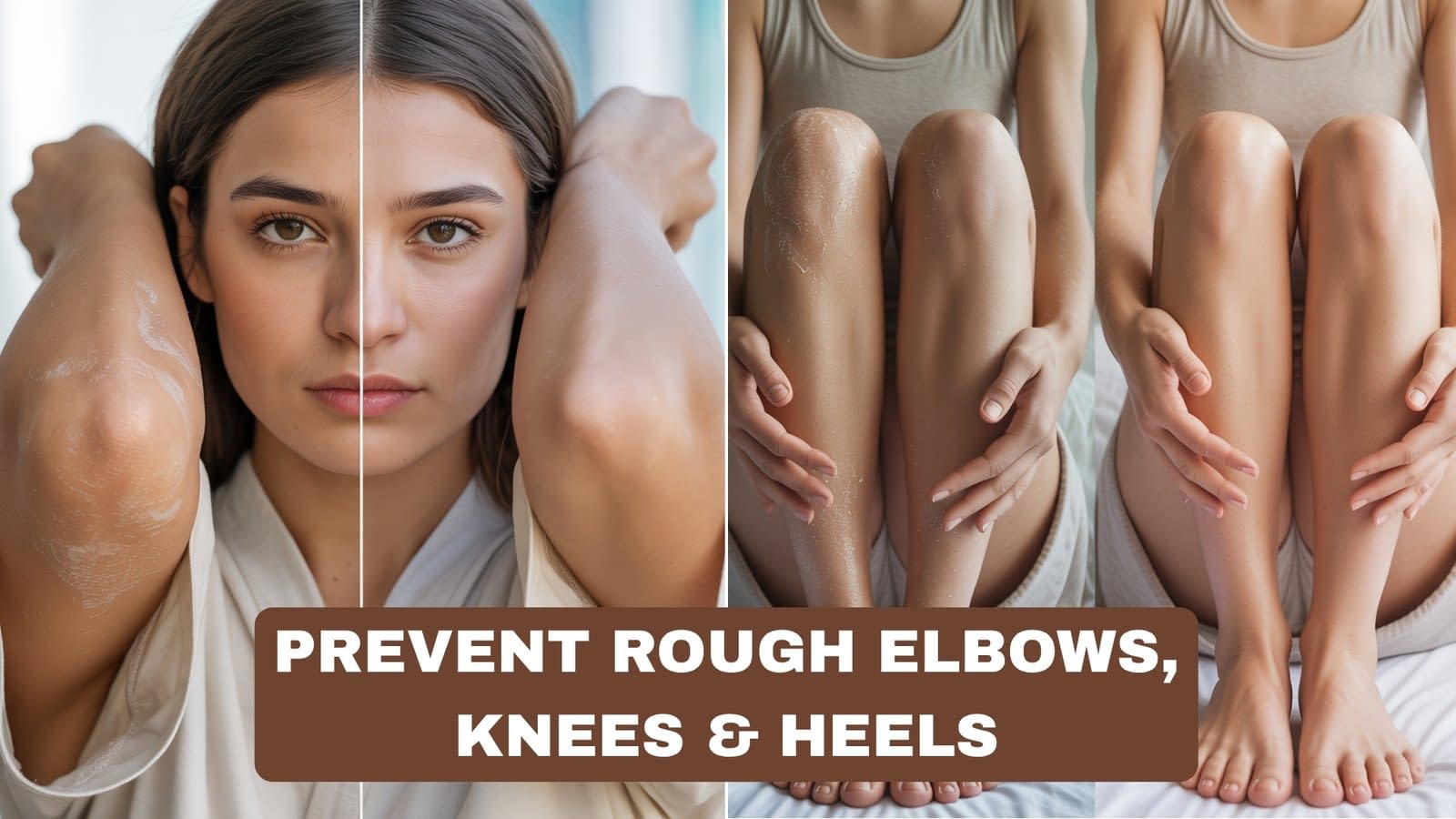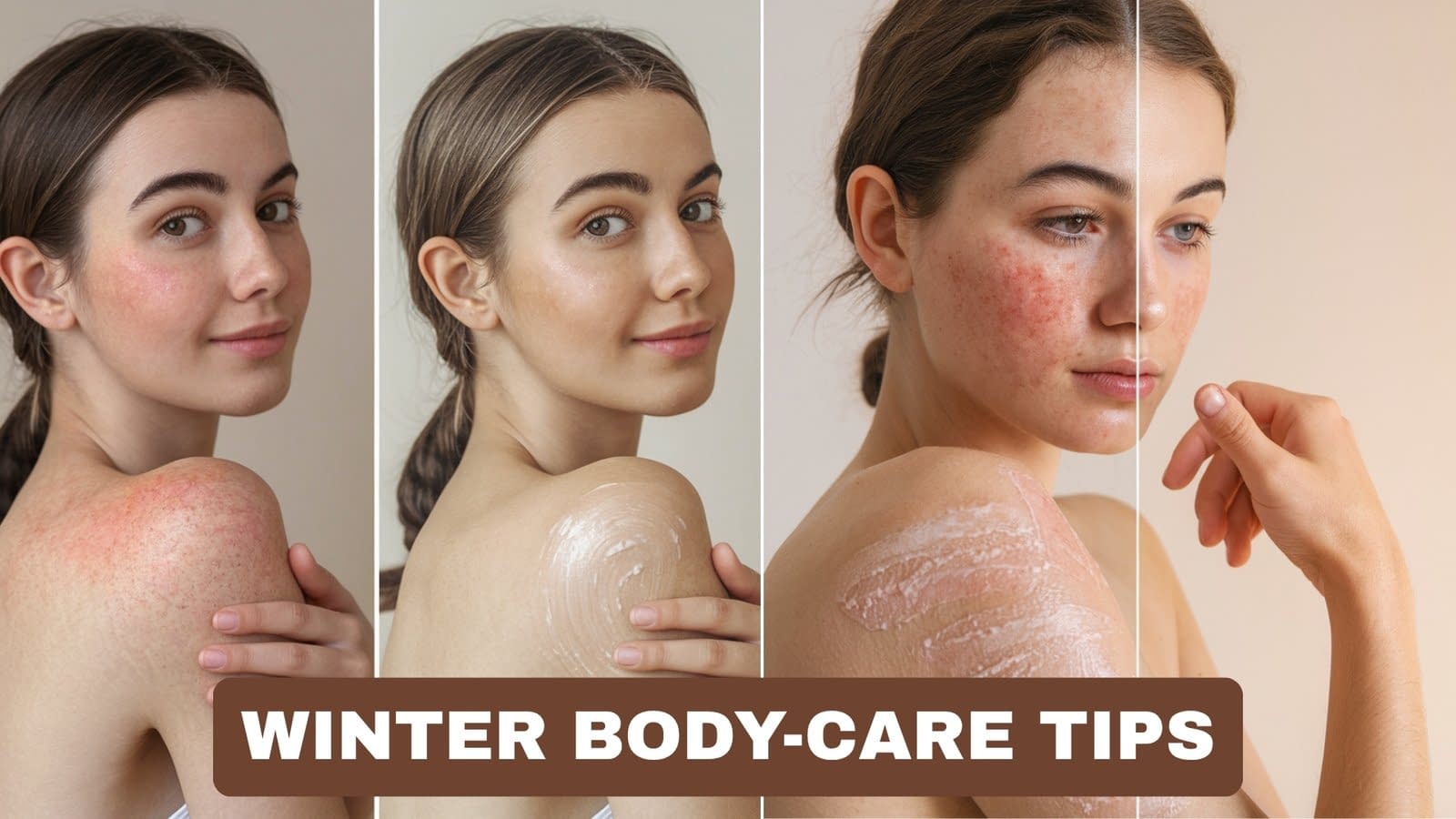Dry, rough hands are annoying, visible, and often a sign you need a simple change in care — not an expensive treatment. This guide gives you everything you need: why hands get rough, a practical daily routine, step-by-step home remedies, scrub recipes, overnight treatments, best oils, protective tactics (especially for winter), and nail/cuticle care. Follow it consistently and you’ll see real improvement in weeks.
Quick safety notes: patch-test new ingredients (apply a small amount behind the ear or inside the wrist and wait 24 hours). Don’t use acidic or abrasive home remedies on cracked, bleeding, or infected hands — see a clinician first.
What Causes Dry and Rough Hands?
A handful of common reasons:
- Loss of moisture (transepidermal water loss). Repeated hand washing, hot water, and harsh soaps strip the skin’s natural oils.
- Environmental exposure. Cold weather, wind, and indoor heating dry out skin.
- Frequent contact with irritants. Household cleaners, detergents, solvents, and even some fragrances damage the skin barrier.
- Occupational or hobby-related friction. Gardening, manual labor, or frequent friction (e.g., tools, paper) cause calluses and rough areas.
- Aging and skin-thinning. Skin becomes thinner and retains less moisture with age.
- Nutritional or health factors. Dehydration, vitamin deficiencies, thyroid disease, or eczema/psoriasis can cause persistent dryness.
- Medications and medical conditions. Some medicines or conditions produce dry skin as a side effect.
Understanding the dominant cause (washing vs weather vs irritants vs underlying condition) helps you pick the most effective fixes.
Is Having Rough Hands Normal?
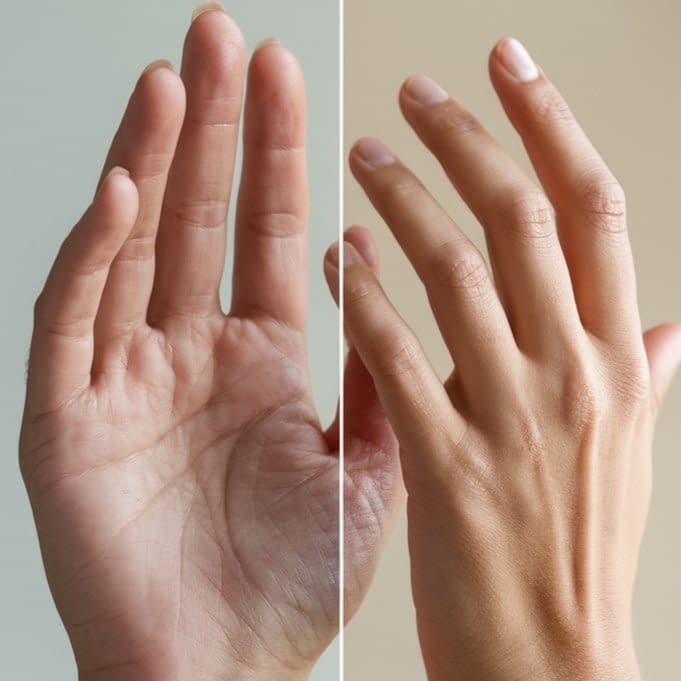
Short answer: yes — it’s common. Many people get rough hands from everyday life. But there are red flags that mean you should get medical advice:
- Cracks that bleed or become infected (red streaks, pus).
- Severe, persistent scaling or itching that doesn’t improve with routine care.
- Sudden onset of extreme dryness together with other symptoms (weight changes, fatigue) — could be systemic.
- Thick, painful calluses or nail changes.
If you have any of the above, see a dermatologist or primary care clinician. Otherwise, most roughness is reversible with consistent, simple care.
Daily Hand Care Routine for Soft, Healthy Skin — Step-by-Step
Follow this routine morning and night; repeat gentle cleansing as needed during the day.
Morning routine (3–5 minutes)
- Gentle cleanse: Use lukewarm water and a mild, fragrance-free cleanser or a syndet (soap-free) wash. Avoid hot showers.
- Pat dry: Don’t rub — blot with a soft towel.
- Apply a lightweight moisturizer: A lotion with glycerin or hyaluronic acid works in the morning. Massage into palms, backs of hands, between fingers, and cuticles.
- Sunscreen: Apply SPF 30+ to backs of hands daily (prevents sunspots and thinning skin). Reapply if outdoors a long time.
Evening routine (5–10 minutes)
- Clean if needed: Rinse off dirt or pollutants.
- Exfoliate (2–3× per week): Use a DIY sugar scrub or a gentle chemical exfoliant (see section 5).
- Apply richer moisturizer: Use a cream or ointment with ceramides, shea, petrolatum or lanolin. These seal moisture better than lightweight lotions.
- Overnight boost: Wear cotton gloves over moisturizer (section 6). Keeps cream from rubbing off and intensifies absorption.
- Cuticle care: Rub a drop of oil into cuticles to keep them flexible and reduce hangnails.
Quick daytime fixes: Carry a small tube of hand cream, reapply after washing, and use hand sanitizer with added moisturizer if you need sanitizing.
Best Natural Home Remedies for Smooth Hands — Recipes & Steps

These remedies are gentle, inexpensive, and effective when used regularly.
A — Honey + Olive Oil Soak (for repair & mild antiseptic action)
Why: Honey attracts moisture and has antimicrobial properties; olive oil moisturizes and repairs barrier.
How:
- Mix 1 tbsp raw honey + 1 tbsp extra virgin olive oil in a small bowl.
- Warm slightly (optional) to body temperature.
- Massage into hands for 1–2 minutes, then leave on for 15–20 minutes.
- Rinse with lukewarm water and pat dry. Apply moisturizer.
Use 2–3× weekly.
B — Oatmeal calming soak (for irritated or eczema-prone hands)
Why: Colloidal oatmeal soothes inflammation and protects the skin barrier.
How:
- Grind 1/2 cup rolled oats into a fine powder.
- Mix in warm (not hot) water to make a hand soak bowl.
- Soak hands 10–15 minutes, pat dry, then apply a thick cream.
Use as needed for calming flare-ups.
C — Avocado + Yogurt Nourishing Mask
Why: Avocado supplies fatty acids; yogurt offers gentle lactic acid and proteins to hydrate.
How:
- Mash 1/4 ripe avocado + 1 tbsp plain yogurt.
- Apply to hands, leave 15–20 minutes, rinse, and moisturize.
Use weekly.
Safety note: Avoid citrus and strong acids on cracked skin; patch test for allergies (especially with nuts like avocado).
DIY Hand Scrubs to Remove Dead Skin — Recipes + How to Use
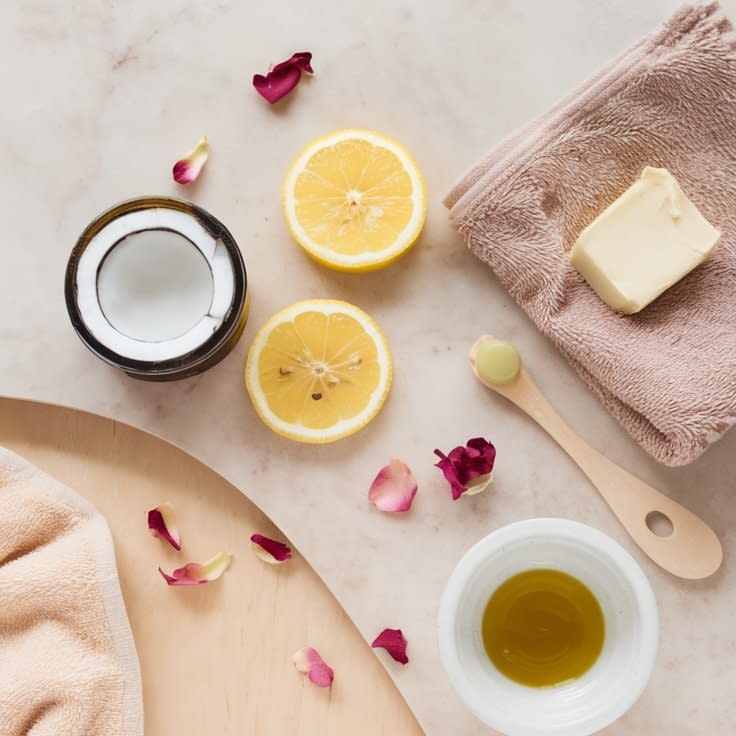
Exfoliation removes dead cells, helps moisturizer penetrate, and smooths texture. Don’t overdo it — 1–2 times per week is enough for most people.
Sugar + Coconut Oil Scrub (gentle)
Ingredients:
- 1 tbsp coconut oil
- 2 tbsp fine sugar (white or brown)
Method:
- Mix into a gritty paste.
- Rub on damp hands in circular motions for 30–60 seconds.
- Rinse, pat dry, and apply moisturizer.
Coffee Grounds + Honey Scrub (energizing & slightly abrasive)
Ingredients:
- 1 tbsp used coffee grounds (cooled)
- 1 tbsp honey
Method:
Same as above. Coffee is slightly more abrasive; avoid if hands are inflamed.
Baking Soda Micro-polish (for callused areas only)
Ingredients:
- 1 tsp baking soda + small water to make paste
Method:
- Gently rub on callused spots only for 15–30 seconds; rinse.
- Follow with heavy moisturizer.
Caution: Baking soda is alkaline and can be drying if used too often — limit to occasional use and don’t use on broken skin.
How to exfoliate safely
- Use gentle pressure; don’t scrub until red.
- Limit to 1–2× weekly.
- Always follow with a rich moisturizer or overnight treatment.
Overnight Moisturizing Treatments for Extra Softness — Step-by-Step
Overnight treatments give long contact time for deep repair.
Basic Overnight Method
- Apply a thick layer of cream (look for petrolatum, shea butter, ceramides).
- Slip on cotton gloves (or clean socks if you don’t have gloves).
- Sleep. Remove and rinse lightly in the morning if hands feel greasy.
Intensive Repair Mask (for very dry/cracked hands)
- Exfoliate gently (sugar scrub) to remove dead skin. Pat dry.
- Massage in a serum: 2 drops vitamin E oil + 1 tsp jojoba oil or olive oil.
- Seal with a thick layer of barrier cream (Vaseline, lanolin or a heavy cream).
- Wear cotton gloves overnight.
Repeat nightly for up to a week for significant improvement.
Natural Oils That Heal Dry Hands Fast — How to Use Them
Oils are building blocks for barrier repair; some also have anti-inflammatory or antimicrobial properties.
Top oils for hands
- Jojoba oil: Closely resembles skin sebum; non-greasy and absorbs well.
- Sweet almond oil: Emollient, rich in fatty acids; great for massage.
- Coconut oil: Antimicrobial and moisturizing — good for short treatments but can clog pores on some people.
- Olive oil: Readily available and nourishing; heavier feel.
- Argan oil: Rich in vitamin E and essential fatty acids; absorbs nicely.
- Rosehip oil: Good for skin repair and pigmentation (use as a treatment oil at night).
- Vitamin E oil: Use sparingly as a booster for dry patches and scars.
How to apply oils
- Warm a few drops between palms.
- Massage into cuticles and entire hand, concentrating on dry patches.
- For deeper effect, apply oil, then a thick cream on top to lock it in (oil alone can evaporate; cream seals).
- For callused areas, massage oil daily for a week; follow with pumice and cream.
Blending tip: Create a small 10 ml roller (jojoba + 5 drops vitamin E + 4 drops lavender) for cuticle massage.
Hand Masks for Deep Hydration — Recipes & Use
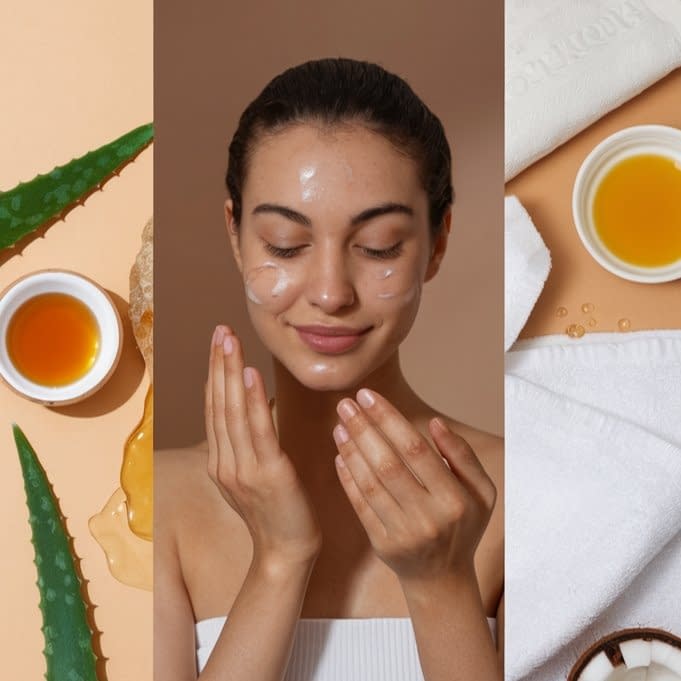
Hand masks are like face masks but for your hands: leave them on for 10–30 minutes for a concentrated dose.
Yogurt + Honey + Oat Mask
- 1 tbsp plain yogurt + 1 tsp honey + 1 tsp oat powder.
Apply 15–20 minutes, rinse, moisturize. Great for soothing and mild exfoliation.
Shea Butter + Olive Oil Balm (leave-on)
- 1 tbsp melted shea butter + 1/2 tsp olive oil.
Apply a thin layer, then gloves overnight for intense hydration.
Aloe + Glycerin Quick Mask (for irritated hands)
- 1 tbsp aloe vera gel + a few drops glycerin.
Apply 10 minutes, rinse, moisturize. Very soothing for redness.
How often: 1–2× weekly as part of your night routine or as needed for a quick reset.
How to Protect Your Hands from Damage — Practical Steps
Prevention is the easiest path to smooth hands.
Work & household protection
- Wear nitrile gloves for wet work and cleaning (latex if tolerated).
- Use cotton liner gloves under rubber gloves for long tasks to reduce sweat friction.
- Rinse and moisturize after glove removal.
Daily habits
- Use a gentle hand soap; avoid antibacterial soaps that strip oils.
- Pat dry, don’t rub. Apply moisturizer immediately after washing.
- Use hand sanitizer with added emollients when soap and water aren’t available.
- Apply sunscreen to hands routinely.
Lifestyle
- Hydrate, eat a balanced diet with essential fatty acids, avoid smoking (it thins skin).
- Keep nails trimmed to reduce hangnails and tearing.
Winter Hand Care Tips to Prevent Cracks
Winter brings wind, cold, and indoor heating — a triple threat.
Winter survival plan
- Swap cleanser: Use an ultra-gentle, cream cleanser.
- Shorter showers: Keep water lukewarm and showers brief.
- Moisturize more often: Apply richer creams after every wash and before going outdoors.
- Barrier balm before going out: Petrolatum or thick balm on exposed skin before leaving home.
- Wear gloves: Insulated gloves for outdoors; cotton gloves indoors if you apply treatments overnight.
- Humidify: Use a humidifier at home to keep indoor humidity around 40–50%.
- Lip & hand pairing: Use the same care for hands and lips (both get dry).
If cracks develop
- Keep wounds clean, use an antiseptic as advised, apply antibiotic ointment for infected cracks, and see a clinician if not improving.
Nail and Cuticle Care for Healthy Hands — Step-by-Step
Healthy nails and cuticles support smooth hands.
Weekly mini-routine
- Soak & soften: Soak hands 5 minutes in warm water with a little mild soap.
- Trim nails: Cut nails straight across and file the corners slightly to avoid ingrown edges.
- Push back cuticles gently: Use a soft orange stick after soaking — don’t cut cuticles (risk of infection).
- Treat hangnails: Clip hangnails with clean nail scissors; don’t tear them.
- Oil & moisturize: Apply cuticle oil (jojoba/vitamin E) and rub into nail beds. Finish with hand cream.
Nail health tips
- Avoid harsh nail polish removers (acetone) frequently; use acetone-free removers when possible.
- Consider a nail hardener if nails are weak, but stop if it causes brittleness.
- If nails are discolored, thickened, or painful — consult a clinician (possible fungal infection).
Final Tips to Maintain Soft and Smooth Hands

A few concise habits that make the biggest difference:
- Moisturize every time you wash your hands. That’s the single most effective habit.
- Use a targeted night treatment with gloves 2–3× per week if hands are very dry.
- Protect during chores — gloves + immediate moisturizer afterwards.
- Cut back on harsh products (fragrance, dyes) until skin recovers.
- Stay hydrated and eat omega-3 rich foods (fish, walnuts, flaxseed) for skin health.
- Be patient and consistent. Skin turnover is ~28 days; give routines 4–6 weeks to show results.
- Seek professional help for persistent, cracking, bleeding, or infected hands.
Quick Cheat-Sheet
Daily
- Gentle wash (lukewarm) → pat dry → apply moisturizer → sunscreen on backs of hands.
Weekly
- 1–2× exfoliate with a sugar scrub.
- 1× nourishing mask or honey-oil soak.
- Nightly richer cream + gloves for intensive repair when needed.
Final Words
Soft hands are less about miracle products and more about routine: protect, hydrate, and repair. Pick a few of the fixes above (gentle cleanser, reapply moisturizer after washing, an overnight treatment) and follow them consistently. In a few weeks your hands will look and feel much healthier — smoother skin, fewer hangnails, and more confidence in that handshake.





